In this trimmed high quality recording of our live event, we discuss the latest financial and property data, examine our latest scenarios, and discuss the trends ahead. We also answer a range of questions posed by our viewers live. The unedited original stream with live chat, is available to view (starting at 0:30) below:
Category: Economic Data
5 Things MYEFO Tells Us
As we come to the end of 2019, you’d be forgiven for being confused about the health of the economy. Via The Conversation.

Treasurer Josh Frydenberg regularly points out that jobs growth is strong, the budget is heading back to surplus, and Australia’s GDP growth is high by international standards.
The opposition points to sluggish wages growth, weak consumer spending and weak business investment.
Monday’s Mid-Year Economic and Fiscal Outlook (MYEFO) provides an opportunity for a pre-Christmas stock-take of treasury’s thinking.
1. Low wage growth is the new normal
Rightly grabbing the headlines is yet another downgrade to wage growth.
In the April budget, wages were forecast to grow this financial year by 2.75%. In MYEFO, the figure has been cut to 2.5%.
Three years ago, when Scott Morrison was treasurer, the forecast for this year was 3.5%.
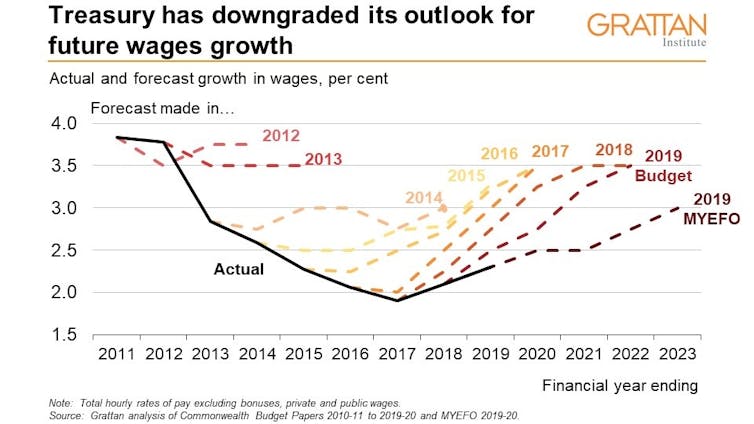
Each time wages forecasts missed, treasury assumed future growth would be even higher, to restore the long-term trend.
Today’s MYEFO is a long-overdue admission from treasury that labour market dynamics have shifted – in other words, lower wage growth is the “new normal”.
Even by 2022-23, wages are projected to grow at only 3% (and even that would still be a substantial turnaround compared to today).
Of course, wages are still rising in real terms (that is, faster than inflation), a fact Finance Minister Mathias Cormann is keen to emphasise.
But Australians will have to adjust to a world of only modest growth in their living standards for the next few years.
2. Economic growth is underwhelming, especially per person
Economic growth forecasts have received a pre-Christmas trim.
Treasury now expects the economy to grow by 2.25% this financial year, down from the 2.75% it expected in April.
Particularly striking is the sluggishness of the private economy, with consumer spending expected to grow by just 1.75%, despite interest rate and tax cuts, and business investment idling at growth of 1.5%, down from the 5% forecast in April.
The longer term picture looks somewhat better, with growth forecast to rise to 2.75% in 2020-21 and 3% in 2021-22, although treasury acknowledges there are significant downside risks, particularly from the global economy.
The government has made much of the fact our economy is strong compared to many other developed nations. But much more relevant to people’s living standards is per-person growth. Australia’s international podium finish looks less impressive once you account for the fact Australia’s population is growing at 1.7%.
As one perceptive commentator has noted, while Australia is forecast to be the fastest growing of the 12 largest advanced economies next year, it is expected to be the slowest in per-person terms.
3. The government is at odds with the Reserve Bank
You can imagine the government’s collective sigh of relief that it is still on track to deliver a surplus in 2019-20, albeit a skinny A$5 billion instead of the the $7 billion previously forecast.
Given the treasurer declared victory early by announcing the budget was “back in the black” in April, missing would have been awkward, to say the least.
And another three years of slim surpluses are forecast ($6 billion, $8 billion and $4 billion respectively).
The real issue for the treasurer is how to deal with the growing calls for more economic stimulus, including from the Reserve Bank.
Depending on what happens to growth and unemployment in the first half of 2020, he will come under increased pressure to jettison the future surpluses to support jobs and living standards.
4. High commodity prices are a gift for the bottom line
High commodity prices are the gift that keeps on giving for the Australian budget.
Iron ore prices in excess of US$85 per tonne, well above the US$55 per tonne budgeted for, have helped to keep company tax receipts buoyant.
Treasury is maintaining the conservative approach it has taken in recent years by continuing to assume US$55 per tonne.
This provides some potential upside should prices stay high – Treasury estimates a US$10 per tonne increase would boost the underlying cash balance by about A$1.2 billion in 2019-20 and about A$3.7 billion in 2020-21.
The budget bottom line remains tied to the whims of international commodity markets for the near future.
5. The surplus depends on running a (very) tight ship
The forecast surpluses over the next four years are premised on an extraordinary degree of spending restraint.
This government is expecting to do something no government has done since the late-1980s: cut spending in real per-person terms over four consecutive years.

The budget dynamics are helping. Budget surpluses and low interest rates reduce debt payments, and low inflation and wage growth reduce the costs of payments such as the pension and Newstart.
But the government is also expecting to keep growth low in other areas of spending, in almost every area other than defence and the expanding national disability insurance scheme.
As the Parliamentary Budget Office points out, it is hard to keep holding down spending as the budget improves.
It is even more true while long term spending squeezes on things such as Newstart and aged care are hurting vulnerable Australians.
Where does it leave us?
The real lesson from MYEFO is that Australians are right to be confused: there is a disconnect between the health of the budget and the health of the economy.
MYEFO suggests both that the government is on track to deliver a good-news budget surplus underpinned by high commodity prices and jobs growth, and that the economy is in the doldrums with low wage growth in place for a long time.
Top of Frydenberg’s 2020 to do list: how to reconcile the two.
Authors: Danielle Wood, Program Director, Budget Policy and Institutional Reform, Grattan Institute; Kate Griffiths, Senior Associate, Grattan Institute
Reality Hits The Budget … Well, Sort Of… [Video]
We review MYEFO (Mid-Year Economic and Fiscal Outlook 2019-20.
How will it impact the “Quiet Australians”?
“Reality” Hits The Budget, Sort Of…
MYEFO has been released, and as expected the Government is still forecasting a surplus, this year down from $7.1 billion to $5 billion, but still a surplus for the first time in 12 years. The surplus for 2020/21 is now seen at $6.1 billion instead of $11 billion as previously estimated. Tax receipts are down 32.6b over 4 years.
Wage growth forecasts were reduced, but are still too optimistic, while the unemployment rate was expected to be higher than hoped at 5.25 per cent, rather than five per cent for this financial year and next.
Treasury still is sticking with a 5% employment threshold below which inflation is expected to rise, while the RBA has this at 4.5%.
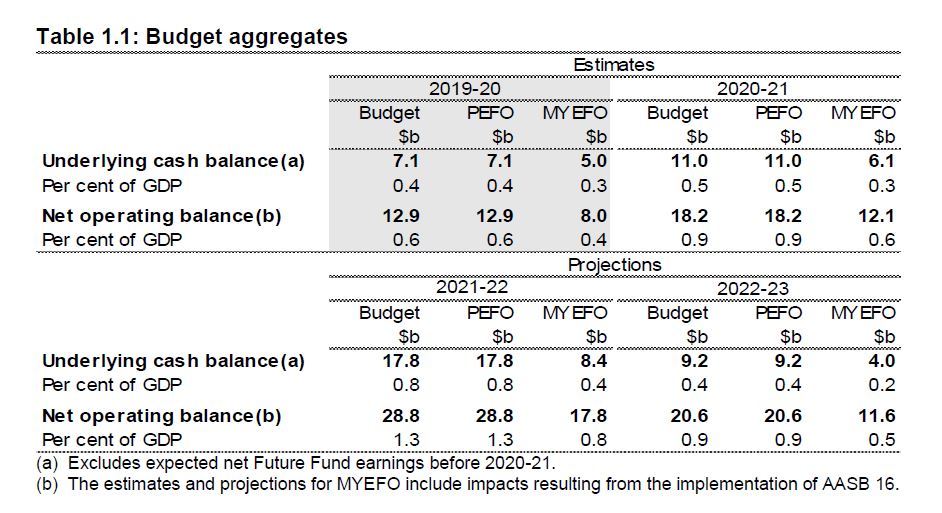
The forecast for economic growth has reduced from 2.75 per cent, to 2.25 per cent. The downgrade to growth was blamed on weak momentum in the global economy, as well as domestic challenges such as the effects of drought and bushfires. The drought in Australia that had already taken a quarter of a percentage point off GDP growth and reduced farm output by a significant amount over the last two years. Growth is then expected to strengthen to 2¾ per cent in 2020-21.
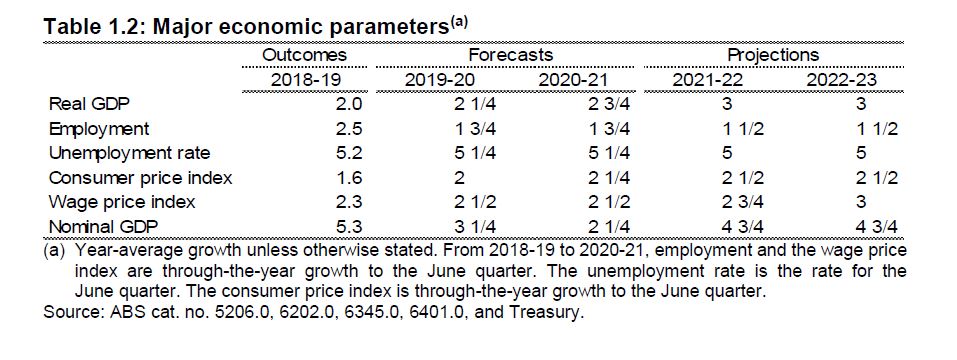
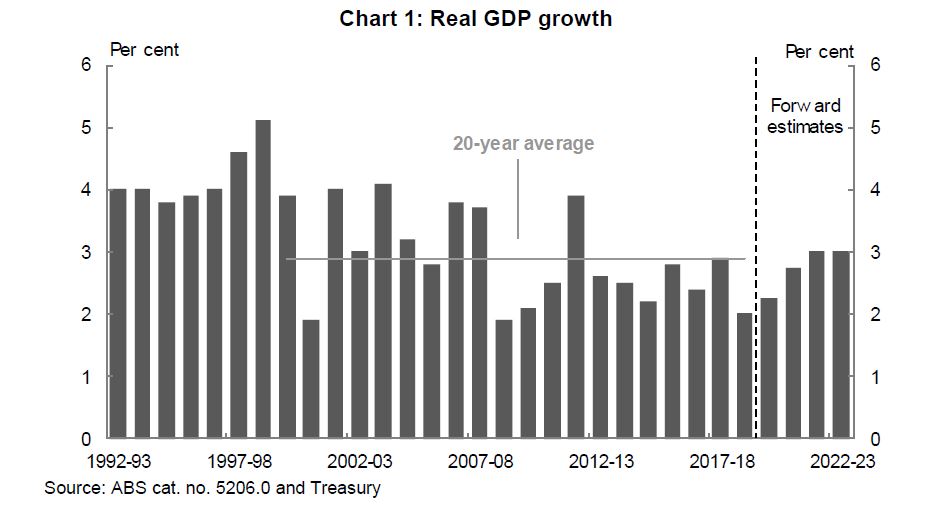
They have shrunk the expected surpluses over the next four years due to a downgrade of tax receipt expectations, with total receipts revised down by $3 billion in 2019/20 and by $32.6 billion over the four years to 2022/23. GST to the states is down nearly 2 billion in the next year, due to weaker activity.
Australia’s interest bill on its debt will fall from $19 billion last year to $14.5 billion (thanks to lower interest rates). Over the next four years this amounts to $13.5 billion savings.
While the mid-year update included a $623.9 million aged care package, there were no other new major spending measures to lift economic growth. This will keep the pressure on the Reserve Bank of Australia to reduce the cash rate even further next year.
In essence, the Treasury is leaving the action to the Reserve Bank, further confirmation we are likely to get more cuts next year.
But they are also counting on stronger house prices leading to a positive wealth effect.
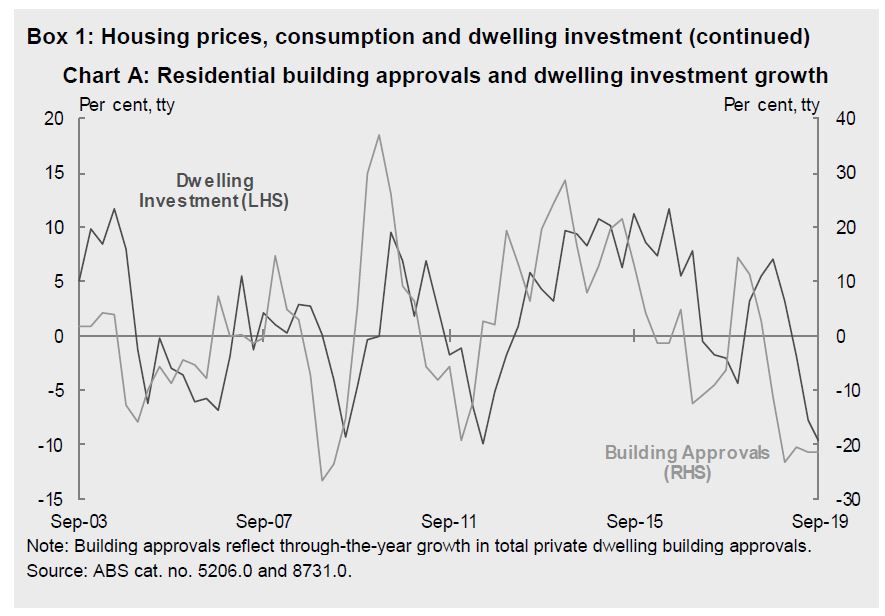
After a recent period of significant falls in housing prices from mid-late 2017 to mid-2019, the established housing market has stabilised. In July 2019, combined capital city housing prices rose for the first time in almost two years, and this has continued in recent months. Although increases have been largest in Sydney and Melbourne, increases have now spread to all cities except Darwin. Overall, combined capital city housing prices are now almost 6 per cent higher than their recent trough in June, although they are still around 5 per cent lower than their peak in September 2017.
This increase in housing prices is expected to support the outlook for household consumption, particularly as corresponding increases in housing turnover should see a pick-up in spending on household goods such as furnishings. More broadly, continued rises in housing prices should provide a boost to confidence and household wealth, as well as increasing borrowing capacity given changes in collateral.
Ownership transfer costs — various fees incurred when fixed assets such as dwellings are sold (including legal and real estate agent fees, stamp duty, and other government charges) — were negatively affected by low rates of housing market turnover in 2018-19 and detracted from real GDP growth. Ownership transfer costs rose by 4.5 per cent in the September quarter 2019 and a further increase supported by stronger housing turnover and prices should contribute to economic growth over the forecast period.
Movements in housing prices impact dwelling investment activity through changes to expected returns to residential construction. However, recent price gains will affect new dwelling investment with a delay. This is because planning and approval processes take time to work their way through into new construction. On average, depending on the type of dwelling, it can take around 2 to 5 months for new dwellings to commence following approval, and a further 6 to 20 months for activity to be completed. High-density dwellings have the longest approval and construction times, and houses the shortest on average.
New dwelling approvals have trended down since late 2017, with the total number of building approvals over the year to October 2019 down by more than 20 per cent from the preceding 12 months and below the 10-year average. The falls in building approvals have been particularly stark in medium-high density dwellings, which also have the longest lag between approval and completion. This means that further moderation in dwelling investment is likely over the forecast period (Chart A). This weakness should be partly offset by a solid pipeline of housing construction work yet to be done.
The other area of sensitivity is the iron ore price and commodity prices in general.
Iron ore spot prices increased sharply in the first half of 2019, mainly due to supply issues in Australia and Brazil, and stronger-than-expected demand from China. Iron ore prices peaked in early July at almost US$120 per tonne free-on-board (FOB). Prices have since fallen, but remain above the price assumed at PEFO. The decline in the price has mainly been due to uncertainty about demand from Chinese steel mills and the recovery in supply. As such, prudent assumptions have been retained and the iron ore spot price is assumed to decline to reach US$55 per tonne FOB by the end of the June quarter 2020. This is one quarter later than was assumed at PEFO.
Coal prices have fallen since PEFO. Metallurgical coal prices have fallen faster and further than had been assumed at PEFO, with the spot price below US$150 per tonne FOB since October 2019. The fall in the spot price is due in large part to uncertainty about demand from Chinese steel mills and policy changes in China. The metallurgical coal price is assumed to remain around recent levels of US$134 per tonne FOB over the forecast period. This is lower than the PEFO assumption, which was for the price to fall to US$150 per tonne FOB by the end of the March quarter 2020.
After reaching a peak of just over US$125 per tonne FOB in mid-2018, thermal coal prices have trended lower, mainly due to increases in seaborne supply and softer global demand. The thermal coal price is assumed to remain around recent levels of US$64 per tonne FOB over the forecast period, below the PEFO assumption of US$91 per tonne FOB.
If the iron ore price were to fall immediately to US$55 per tonne FOB, two quarters earlier than assumed, nominal GDP could be around $7.5 billion lower than forecast in 2019-20 and $0.3 billion lower in 2020-21. This would have a negative flow-on impact to company tax receipts estimated at around $0.8 billion in 2019-20 and $1.1 billion in 2020-21.
By contrast, if the iron ore price remained elevated for two quarters longer than currently assumed, before falling immediately to US$55 per tonne FOB, nominal GDP could be around $6.4 billion higher than forecast in 2019-20 and $1.0 billion higher in 2020-21. This would have a flow-on impact to company tax receipts estimated at
around $0.5 billion in 2019-20 and $1.3 billion in 2020-21.The actual impact on company tax receipts may vary due to timing of tax collections and the availability of tax losses.

IMF On Australia: Risk To The Outlook Remains Tilted To The Downside
The IMF published their latest preliminary findings at the end of an official IMF staff visit (or ‘mission’) to Australia. They recommend preparing for risk from a rapid housing credit upswing, by introducing loan-to-value and debt-to-income limits, and possibly a sectoral countercyclical capital buffer targeting housing exposures. Plus transitioning from a housing transfer stamp duty to a general land tax to improve efficiency by easing entry into the housing market and promoting labor mobility, while providing a more stable revenue source for the States. Such reforms could be complemented by reducing structural incentives for leveraged investment by households, including in residential real estate.
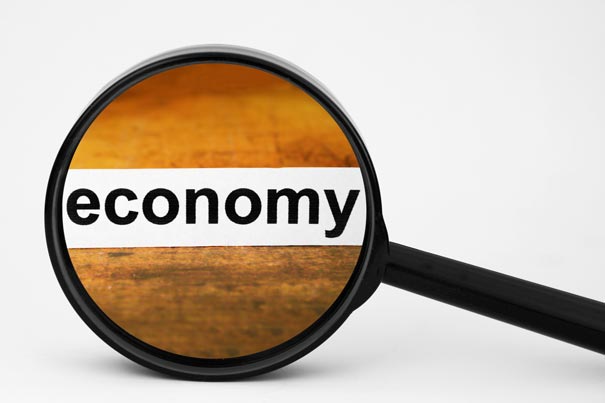
Economic growth has gradually improved from the lows in the second half of 2018 but has remained below potential. Growth has been supported by public spending, including on infrastructure, and net exports, which have held up well despite headwinds from global policy uncertainty and China’s economic slowdown. However, domestic private demand has remained weak amid subdued confidence, with a widening output gap. In addition, the ongoing drought has been a drag on economic growth. Wage growth has remained sluggish, reflecting persistent labor market slack, and inflation and measures of inflation expectations have dropped to below Australia’s 2 to 3 percent target range. Following a marked adjustment over the past two years, housing prices have started to recover, particularly in Sydney and Melbourne.
Growth should continue to recover at a gradual pace. Following growth of about 1.8 percent in 2019, the economy is expected to expand by 2.2 percent in 2020.Private domestic demand is expected to recover slowly, supported by monetary policy easing and the personal income tax cuts. An incipient recovery in mining investment is also expected to contribute to growth. In addition, the house price recovery will likely reduce the drag on consumption from earlier, negative wealth effects. That said, residential and non-mining business investment are expected to take longer to recover. Over the medium term, growth is expected to reach the mission’s estimate of potential growth of about 2½ percent, supported by infrastructure spending and structural reforms. With continued labor market slack, underlying inflation will likely stay below the target range until 2021.
Risks to the outlook remain tilted to the downside.
· On the external side, Australia is especially exposed to a deeper-than-expected downturn in China through exports of commodities and services. A renewed escalation of U.S.-China trade tensions could further impair global business sentiment, discouraging investment in Australia. A sharp tightening of global financial conditions could squeeze Australian banks’ wholesale funding and raise borrowing costs in the economy.
· On the domestic side, private consumption could be weaker should a cooling in labor markets squeeze household income. Adverse weather conditions, including a more-severe-than-expected drought, could further disrupt agriculture, dampening growth. On the upside, looser financial conditions could re-accelerate asset price inflation, boosting private consumption but also adding to medium-term vulnerabilities given high household debt levels.
With below-potential growth, weakening inflation expectations, and continued downside risks, the macroeconomic policy mix should remain accommodative.
· Monetary policy has been appropriately accommodative, and continued data-dependent easing will be helpful to support employment growth, inflation and inflation expectations.
· The consolidated fiscal stance is appropriately expansionary for FY2019/20. Fiscal policy will be supportive for demand via reductions in personal income and small business corporate taxes, additional infrastructure spending, and the government’s announced support measures for small- and medium-sized enterprises (SMEs). However, fiscal policy aggregated across all levels of government will be contractionary in FY2020/21, as state-level infrastructure investment is expected to decline.[1] States should reconsider this and attempt to at least maintain their current level of infrastructure spending as a share of GDP to continue addressing infrastructure gaps and supporting aggregate demand.
The authorities should be ready for a coordinated response if downside risks materialize. Australia has substantial fiscal space it can use if needed. In addition to letting automatic stabilizers operate, Commonwealth and state governments should be prepared to enact temporary measures such as buttressing infrastructure spending, including maintenance, and introducing tax breaks for SMEs, bonuses for retraining and education, or cash transfers to households. In case stimulus is necessary, the implementation of budget repair should be delayed, as permitted under the Commonwealth government’s medium-term fiscal strategy. In addition, unconventional monetary policy measures such as quantitative easing may become necessary in such a scenario as the cash rate is already close to the effective lower bound.
The macroprudential policy stance remains appropriate but should stand ready to tighten in case of increasing financial risks. Australian banks remain adequately capitalized and profitable, but vulnerable to high exposure to residential mortgage lending and dependent on wholesale funding. While the risk structure of mortgage loans has been significantly improved, renewed overheating of housing markets and a fast pick-up in mortgage lending remain risks in a low-interest-rate environment. The Australian Prudential Regulation Authority (APRA) should continue to expand and improve the readiness of the macroprudential toolkit. This should include preparations, for potential use in the event of a rapid housing credit upswing, for introducing loan-to-value and debt-to-income limits, and possibly a sectoral countercyclical capital buffer targeting housing exposures.
Strong reform efforts to bolster the resilience of the financial sector should continue. The mission supports the authorities’ plan to further enhance banks’ capital framework, including strengthening their loss-absorbing capacity and resilience. In addition, encouraging banks to further lengthen the maturity structure of their wholesale funding would help mitigate ongoing structural liquidity risks. The authorities’ commitment to implement the recommendations made by the Hayne Royal Commission by end-2020 is welcome. The improvement in lending standards further enhances financial sector resilience, and reducing the uncertainty in the enforcement of responsible lending obligations would prevent excessive risk aversion in the provision of credit. The authorities should implement the APRA Capability Review’s recommendations to strengthen APRA’s resources and operational flexibility, enhance its supervisory approach in assessing banks’ governance and risk culture, and strengthen enforcement efforts. In addition, reinforcing financial crisis management arrangements and strengthening the AML/CFT regime should remain priorities, in line with the findings of the 2018 Financial Sector Assessment Program (FSAP).
Housing supply reforms remain critical for restoring affordability. More efficient long-term planning, zoning, and local government reform that promote housing supply growth, along with a particular focus on infrastructure development, including through “City Deals”, should help meet growing demand for housing.
Efforts to boost private investment and innovation should be stepped up. Non-mining business investment, including R&D, has been sluggish, contributing to lower productivity growth. Reducing domestic policy uncertainty, supporting SMEs’ access to finance, and accelerating structural reforms would help to improve the investment environment. Building on reforms in the 2015 Harper Review, Australia can further improve product market regulations, including by simplifying business processes through the work of the Deregulation Taskforce. The ongoing policy priority on skills and education reforms is welcome to improve the environment for innovation, and consideration should be given to faster implementation of the recommended measures in the Australia 2030: Prosperity through Innovation report. Government initiatives to relieve SME financing constraints are welcome, including the Australian Business Securitization Fund and the Australian Business Growth Fund. Incentives for banks to lend more to businesses, including through reducing the concentration in mortgages, can help support business investment, as can the promotion of venture capital. Supporting new investment through tax measures, possibly including targeted investment allowances, as well as further improving the effectiveness of government R&D support for younger firms, would also be helpful.
Australia’s continued efforts supporting international cooperation are welcome. The mission welcomes the authorities’ support to enhance the effectiveness of the WTO and pursuit of the Regional Comprehensive Economic Partnership (RCEP), which aims to liberalize trade and improve quality and environmental standards and labor mobility throughout the Asia and Pacific region. Developing a national, integrated approach to energy policy and climate change mitigation, and clarifying how existing and new instruments can be employed to meet the Paris Agreement goals, would help reduce policy uncertainty and catalyze environmentally-friendly investment in the power sector and the broader economy.
Further reforms can help to promote female labor market participation and reduce youth underemployment. There is scope to increase full-time employment for Australian women and addressing persistently high underemployment particularly among youth. The 2018 Child Care Subsidy program and the forthcoming Mid-Career Checkpoint program are expected to support women in work. This could lay the foundation for a broader review of the combination of taxes, transfers, and childcare support to reduce disincentives for female labor force participation. Pursuing ongoing reforms in vocational training can help reduce youth underemployment.
Broad fiscal reforms would help promote efficiency and inclusiveness. Australia should continue to reduce distortions in its tax system to promote economic efficiency and in doing so should be mindful of distributional consequences considering income inequality. Recent reforms in personal and corporate income taxes have helped to improve the efficiency of the tax system. A further shift from direct to indirect taxes could be made by broadening the goods and services tax (GST) base and reducing the statutory corporate income tax rate for large firms. The impact of these reforms could be made less regressive for households through targeted cash transfers. Transitioning from a housing transfer stamp duty to a general land tax would improve efficiency by easing entry into the housing market and promoting labor mobility, while providing a more stable revenue source for the States. Such reforms could be complemented by reducing structural incentives for leveraged investment by households, including in residential real estate.
The mission would like to thank the authorities and counterparts in the private sector, think tanks, and other organizations for frank and engaging discussions.
Kitchen Sink From The Fed – Up To $365 Billion In The Next Month!
The Fed appears to be concerned about end of the year liquidity, judging by their latest statement on their repo operations.
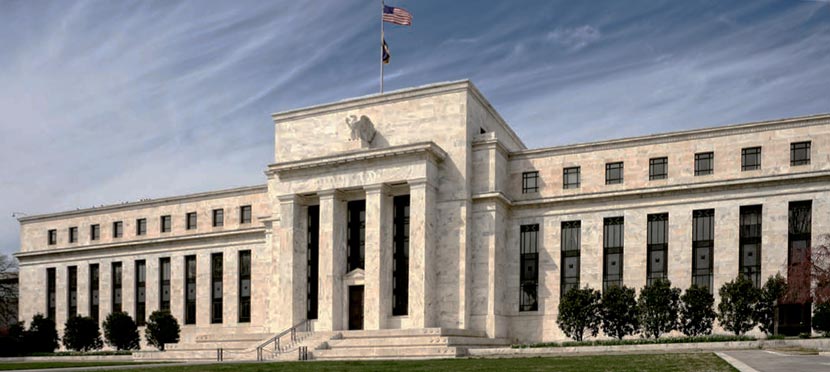
The Open Market Trading Desk (the Desk) at the Federal Reserve Bank of New York has released the schedule of repurchase agreement (repo) operations for the monthly period from December 13, 2019 through January 14, 2020. In accordance with the most recent FOMC directive, the Desk will conduct repo operations to ensure that the supply of reserves remains ample and to mitigate the risk of money market pressures around year end that could adversely affect policy implementation.
The Desk will continue to offer two-week term repo operations twice per week, four of which span year end. In addition, the Desk will also offer another longer-maturity term repo operation that spans year end. The amount offered in this operation will be at least $50 billion.
Overnight repo operations will continue to be held each day. On December 31, 2019 and January 2, 2020, the overnight repo offering will increase to at least $150 billion. In addition, on December 30, 2019, the Desk will offer a $75 billion repo that settles on December 31, 2019 and matures on January 2, 2020.
The Desk intends to adjust the timing and amounts of repo operations as needed to mitigate the risk of money market pressures that could adversely affect policy implementation, consistent with the directive from the FOMC.
Detailed information on the schedule and parameters of term and overnight repurchase agreement operations are provided on the Repurchase Agreement Operational Details site.
So, the NY Fed will continue to offer two-week term repo operations twice per week, four of which run across the end of the year end. Plus, they will also offer another longer-maturity term repo operation that spans year end. The amount offered in this operation will be at least $50 billion.
Beyond that, they announced that the overnight repo offering will increase to at least $150 billion to cover the “turn” in a flood of overnight liquidity. And on December 30, 2019, the Desk will offer a $75 billion repo that settles on December 31, 2019 and matures on January 2, 2020.
And they leave the door open to more if need by saying “intends to adjust the timing and amounts of repo operations as needed to mitigate the risk of money market pressures that could adversely affect policy implementation, consistent with the directive from the FOMC.”
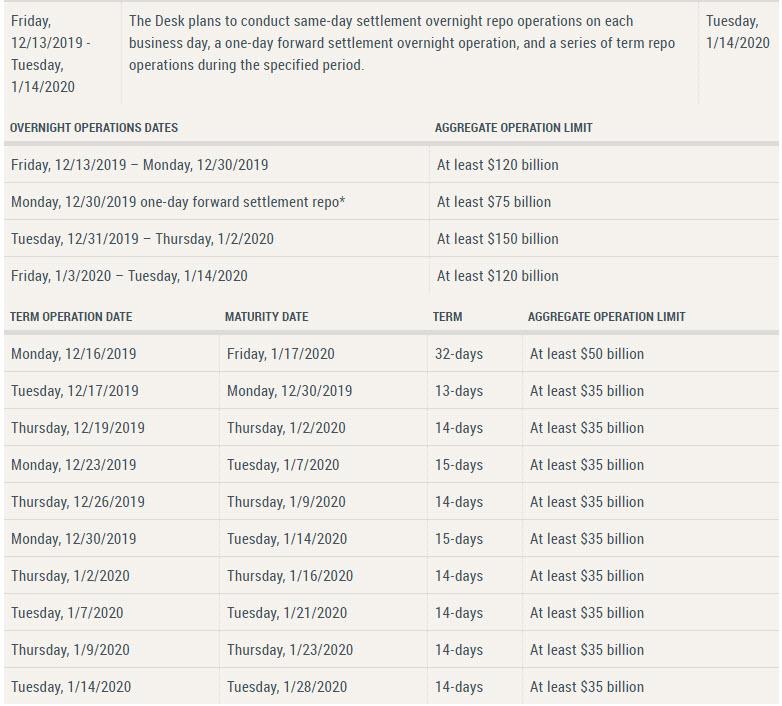
So in essence, as well has growing the size its overnight repos to $150 billion, the Fed will run nine term repos covering the year-end turn from Dec 16th to Jan 14th, 8 of which will amount to $35 billion and the first will be $50 billion, for a total injection of $365 billion in the coming month.
This is what the Fed Balance Sheet might look like. If this is not QE, I do not know what is….
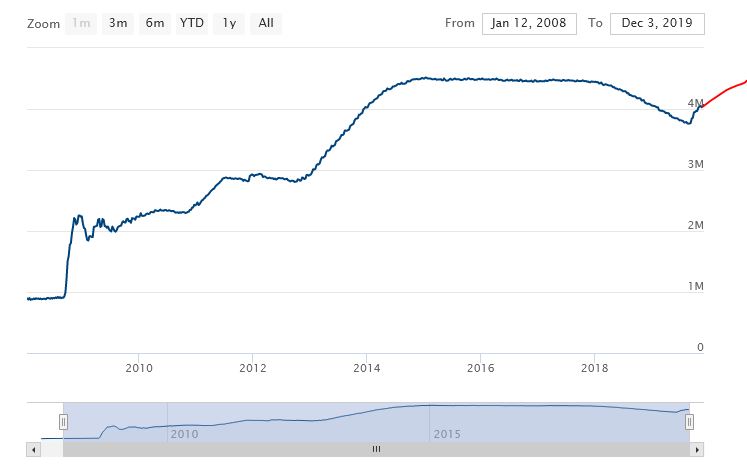
The core question is what are they afraid of?
MYEFO – What To Expect
On Monday the Australian government will release the Mid-Year Economic and Fiscal Outlook (MYEFO). This will – as required by the Charter of Budget Honesty – provide an update on the key assumptions made in this year’s budget, and track the implications of decisions made since the budget for the projected surplus. Via The Conversation.

There are two things you can count on about MYEFO.
First, the government will have to pare back its forecasts for economic growth, wages growth and employment growth.
Second, no matter what the economic reality is, the forecast for a budget surplus will remain.
The government has made economic management – as measured by the rather dubious criterion of budget balance – the central plank of its electoral strategy. As the Australian National University’s 2019 Australian Election Study revealed, voters preferred the government’s economic policies to Labor’s by a wide margin (47% to 21%, with 17% thinking there was no difference). On the management of government debt, the margin was 44% to 18%.
But the economy isn’t doing very well. GDP annual growth is 1.7%, not the 2.75% forecast in the budget. The unemployment rate is 5.3%, compared to the forecast of 5.0%. Wage growth is 2.2%, not the 2.75% forecast.
Iron ore supplements
The forecast budget surplus for the fiscal year to June 2020 will be made to hang together, thanks to a higher-than-forecast iron ore price.
That price – which determines the dollar value of Australia’s biggest export and hence the tax revenue it generates – is not reflected in the GDP figure, which only takes into account volumes.
The iron-ore price is now US$92.50 a tonne. The budget assumed the average price would be $US88 for the 2020 budget year, thanks to a reduction in the international supply of iron ore caused by a tailings dam bursting in January at the Córrego do Feijão mine near the town of Brumadinho in southeastern Brazil.
The dam’s collapse released a tsunami of sludge that destroyed farms, houses, roads and bridges, and killed 272 people.
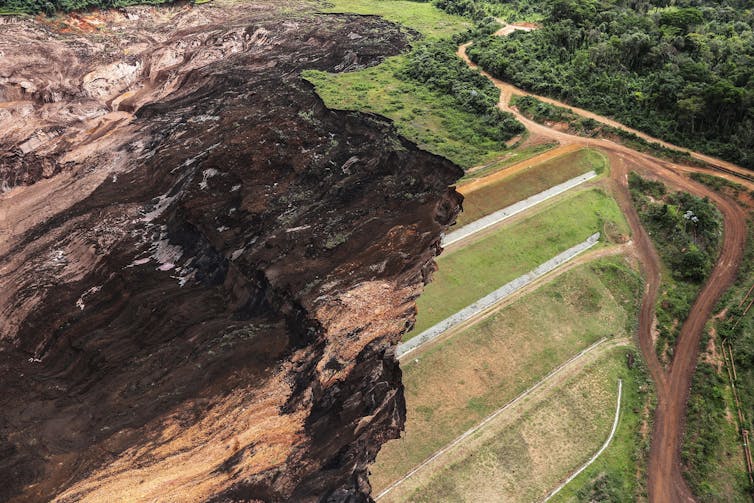
Ensuing mine shutdowns reduced iron ore output from operator Vale (the world’s biggest iron ore miner) by about a third. This in turn led to the price of iron ore this year being very high, as the following chart illustrates.
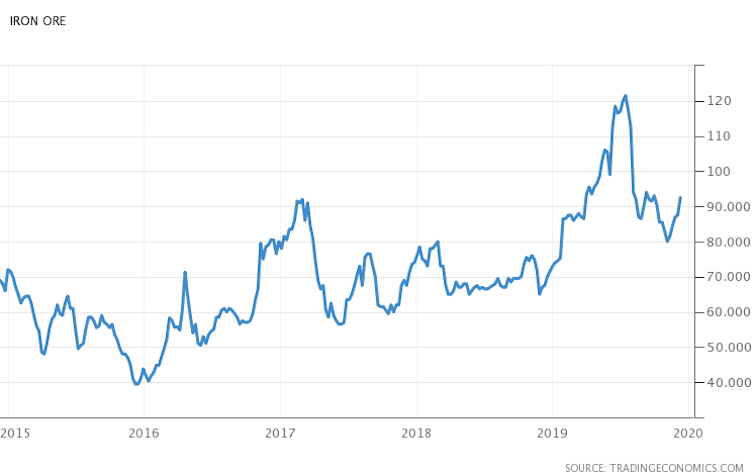
The Australian government sensibly assumed the Brazilian mine would come back online and the ore price would revert to $US55 per tonne by March 2020.
But just think about the 2020-21 fiscal year. The government’s own sensitivity analysis shows for the full 2020-21 budget year a difference in the iron ore price of US$10 a tonne translates to a A$3.7 billion difference in the budget bottom line.
That has helped this year, but it also shows how dependent the budget’s relatively small A$7.1 billion “underlying cash balance” is on a commodity price that’s out of our control.
Yet, given the political non-negotiability of the surplus, we can expect assumptions that stretch credulity to maintain a surplus forecast.
Some action?
This is all against a backdrop of calls for fiscal stimulus from the governor of the Reserve Bank of Australia, the Business Council, every mainstream economist and recently Australia’s top chief executives.
But any stimulus meaningful enough to boost the ailing economy would blow the budget surplus. And the assumptions have already been stretched to breaking point, so there’s very little room for the government to manoeuvre.
The government will probably announce some sort of “investment allowance” – where companies get a modest tax break for specific types of investments in the short term. As I have argued before, this will do something to boost investment and the economy generally, but not nearly as much as a full-scale reduction in the company tax rate to 25% for all businesses.
But the government can’t afford to do a proper tax cut because of its devotion to a wafer-thin surplus.
The danger of too little action
In the end, what the government ends up announcing will really be an allocation of responsibilities. It will determine how much of the work of economic recovery it will do itself, and how much it will want to palm off to the Reserve Bank.
The downside of the former is losing the budget surplus.
The downside of the latter is that the Reserve Bank will have no choice but to cut the cash rate to 0.25% in early 2020 and then embark upon a bond-buying program – i.e. “quantitative easing” or “QE”.
As even Reserve Bank governor Philip Lowe has himself admitted, more aggressive monetary policy brings with it the (further) risk of asset-price bubbles and financial instability.
Right now the government is putting all its chips on the surplus. Will that turn out to be a good bet? Time will tell.
2020 will reveal much about the future of the Australian economy and whether we manage to escape dramatic problems like a recession.
We live in interesting times – but perhaps more in the “Ancient Chinese curse” kind of way than any of us would like.
Author: Richard Holden, Professor of Economics, UNSW
The Cash Ban Cowards Can’t Hide The Truth!
Today the Senate held their first hearing (at short notice) on the Cash Restrictions Bill.
I discuss the lead up and hearing with Robbie Barwick.
Note the next hearing has been scheduled for SYDNEY on 29th January 2020!
https://www.aph.gov.au/Parliamentary_Business/Committees/Senate/Economics/CurrencyCashBill2019
You can watch the full sessions via ParlView: http://parlview.aph.gov.au/browse.php
Dodging the Debt Disaster with Prof. Steve Keen | Nucleus Investment Insights
In the latest from Nucleus Wealth, Head of Investment Damien Klassen, and Head of Operations Tim Fuller, chat with Economist and Hon. Prof. of the University College of London, Steve Keen.
You can find Steve’s work at: https://www.patreon.com/ProfSteveKeen
Topics include credit creation and its limits, weighing up its pro’s and con’s, central banks reaching the end of the road for interest rate cuts with debt being at near record highs, the drivers of weak demand and inflation globally, Modern Monetary Theory (MTT) and its differences with Keynesian Stimulus, which countries are closest to incorporating MMT, Steve’s ideas for central banks depositing directly into citizens bank accounts and “Universal Basic Carbon.” Nucleus Wealth is a Melbourne based investment house that can help you reach your financial goals through transparent, low cost, ethically tailored portfolios.
Listen in podcast form: http://bit.ly/NucleusPod
Disclaimer: The information on this podcast contains general information and does not take into account your personal objectives, financial situation or needs. Past performance is not an indication of future performance. Damien Klassen and Tim Fuller are an authorised representative of Nucleus Wealth Management. Nucleus Wealth is a business name of Nucleus Wealth Management Pty Ltd (ABN 54 614 386 266 ) and is a Corporate Authorised Representative of Nucleus Advice Pty Ltd – AFSL 515796
Adam And I Chat…
I was interviewed by Adam Stokes who runs his own YT channel, mainly covering Crypto. This is my version of the discussion.
The show covered a wide range of issues, from Crypto, Central Banks, Cash Bans and Negative Rates through to politics and democracy.
Adam’s version: https://www.youtube.com/watch?v=vWzhuqM_aoU
Check out his channel: https://www.youtube.com/user/adamstokes224
